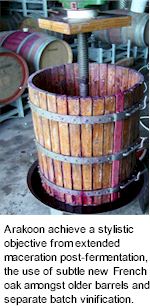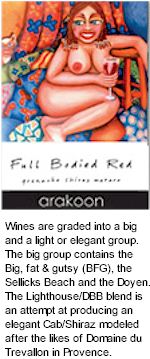


Let there be no doubt, the wine is made in the vineyard. The source fruit can vary greatly from vintage to vintage. In order to obtain a certain degree of consistency, batches are processed as separately as possible followed by a final blending, assembling wines into unique styles. Elegance with power, aspirations which are not always easy to reach. Arakoon maximize quality by interacting with growers as much as possible, and by choosing growers who are interested in producing high quality fruit, rather than just high quantity. Processing, maturation, blending and bottling are also important and that is where the winemaking part comes in.

Arakoon aim at producing styles which the winemakers themselves would like to drink. Inspirational producers around the world include amongst others: Guigal, Graillot, Rayas, Clape, Pegau, Trevallon, Rousseau and J.J. Confuron (reds), and FX Pichler, Knoll, Coche-Dury, Marcel Deiss and JJ Prum (whites). Whithin Australia, Arakoon are fans of Mount Mary, Noons, Bowen's, Summerfield, Wendouree, Lakes Folly and Jasper Hill. Notably, Australia and McLaren Vale produces grapes that differ from the European favourites, so physical emulations are therefore impossible. The quality however that these producers routinely achieve is very much a target to emulate.
Arakoon believe that experimentation is the key to achieving higher and higher levels of quality. It is easy to make a prediction of what happens in response to certain treatments, however, any real answer will only come from trials. Tests are routinely conducted with synthetic corks vs. a range of natural corks, the number of times a wine should be racked, the effect of fining rates, primary fermentation in barrel vs. vat, pre- and post-fermentation maceration, etc... and there is more to come.
After tasting Arakoon you may become surprised that some of the wines taste quite different from most other South Australians, more elegant and understated perhaps. This is a stylistic objective resulting from extended maceration post-fermentation, the use of subtle new French oak amongst other old barrels and blending towards the above stated aim. These styles sometimes are a better match with food rather than big and overtly fruity wines.

Wines are graded into a big and a light or elegant group. The big group contains the Big, fat & gutsy (BFG), the Sellicks Beach and the Doyen. The remainder are more on the lighter side. Sellicks Beach/BFG blend is based on little new wood and wines that have a porty, jammy element in them, whilst reserve Shiraz and the doyen are more stamped by subtle new French oak and varietal aromas. The Lighthouse/DBB blend is an attempt at producing an elegant Cabernet Shiraz modeled after the likes of Dom. du Trevallon in Provence.
Arakoon don't own or manage vineyards but they have firm views on viticulture. Since inaugural vintage, Aakoon have brought in grapes from vines that have yielded miserably and from vines that have had reasonably large crops, from vines that were two years young, up to a hundred years old, from vines that have ripened their fruit early and late, and with varying degrees of ripeness (10.5 to over 16% potential alcohol!). In Summary, the best wine so far (doyen) have come from two year old vines that ripened early. Arakoon have seen examples where low yielding vines produce wine that is not too special, whilst reasonably high yielding vines give very nice fruit (and therefore wine). At vintage, Arakoon produce a large range of varying batches that differ in grape, geographical origin and winemaking treatments. Some vineyards are harvested at two ripeness levels. The different batches are kept separate all the way until blending. For such a tiny winery, Arakoon can end up with a substantial number of batches, between 15-25 depending on the vintage. Subsequently the batches are grouped according to style or potential. Not only structure, but flavours are considered.
In essence, Arakoon aim at styles, as opposed to grape varieties and origin. McLaren Vale is famous for big, fruity wines that are influenced by new american oak. Not all wines are that way of course, but, it could be argued that this is somewhat of a South Australian style, if any. Arakoon on the other hand are quite subdued and different stylistically from the South Australian style. It comes down to a consistent employment of post-ferment maceration and choice of oak. Blending also plays a role. Like Frank Sinatra, Arakoon like things done their own way! The only way to really find out for yourself is not to read, but to try it out in practice.
